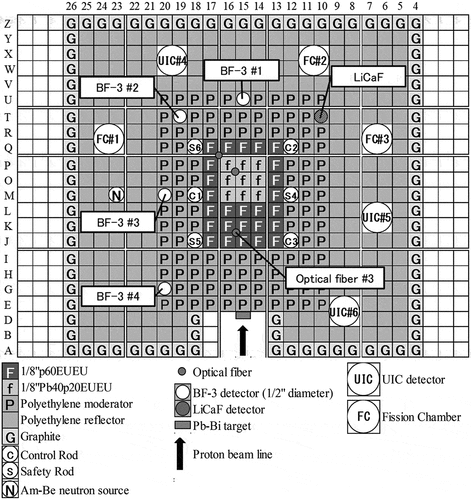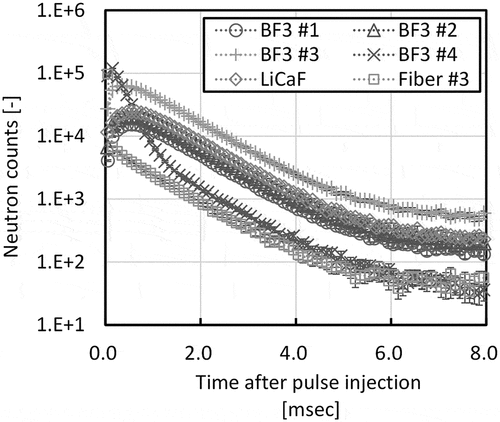 ?Mathematical formulae have been encoded as MathML and are displayed in this HTML version using MathJax in order to improve their display. Uncheck the box to turn MathJax off. This feature requires Javascript. Click on a formula to zoom.
?Mathematical formulae have been encoded as MathML and are displayed in this HTML version using MathJax in order to improve their display. Uncheck the box to turn MathJax off. This feature requires Javascript. Click on a formula to zoom.ABSTRACT
The robustness of the linear combination method to neutron source is demonstrated in the pulsed neutron source (PNS) experiment. The linear combination method reduces the spatial higher-mode (HM) components in neutron flux distribution by integrating the neutron counts obtained in the PNS experiment with the linear combination. In the previous study, we have confirmed the applicability of the linear combination method based on the PNS method conducted at Kyoto University Critical Assembly (KUCA) with a deuteron-tritium (D-T) neutron source. In this study, the PNS experiment is conducted at KUCA with 100 MeV proton accelerator and Pb-Bi target. The experiment is aimed at showing that the masking time dependence of the estimated prompt neutron decay constant is dramatically reduced by the linear combination method compared to the conventional method: these results demonstrate the linear combination method is applicable to spallation neutron source as well as D-T neutron source.
1. Introduction
The Japan Atomic Energy Agency has proposed an accelerator-driven system (ADS) as an option for practical nuclear transmutation of minor actinides (MAs) and long-lived fission products in high-level radioactive wastes produced by the light-water reactors [Citation1,Citation2]. Due to relatively small values of the delayed neutron fraction of MA nuclides loaded as the fuel, ADS core is operated in a subcritical state to obtain a sufficient margin from a prompt critical state and driven by a spallation neutron source generated with a proton accelerator and a lead bismuth eutectic (LBE) target. Then, subcriticality governs a power gain of the core to beam current of the proton accelerator, since spallation neutrons are multiplied through the subcritical neutron multiplication. In the research and development of the ADS, developments of measuring and monitoring of the subcriticality are particularly important. Various methods of subcriticality measurements have been proposed and examined, including the neutron source multiplication method [Citation3], the reactor noise analysis method [Citation4], and the pulsed neutron source (PNS) method [Citation5,Citation6] using an external pulsed neutron source.
Among these methods, the PNS method has been considered as one of the practical measurement methods of subcriticality because of its capability of measuring a wide range of subcriticality [Citation7]. Also, in the PNS method, there are two different techniques: the Sjöstrand method (also known as the area ratio method), and the α-fitting method [Citation5,Citation6]. As feasibility studies on ADS, the PNS method has been validated through the experiments with 14 MeV D-T neutron source at the MASURCA [Citation8], the YALINA [Citation9], and the VENUS-F [Citation10] and with the spallation neutron source consisting of 100 MeV proton accelerator and Pb-Bi target at the Kyoto University Critical Assembly (KUCA) [Citation11,Citation12].
Measurement results of the subcriticality by the PNS method depend on detector positions since the PNS method is theoretically based on the 1-point reactor approximation. The spatial higher-mode (HM) effect becomes larger as the subcriticality gets deeper and it degrades the accuracy of the measurement result of the subcriticality [Citation13]. For the α-fitting method, the masking technique has been proposed to reduce the HM effect [Citation14]. While the masking technique has the capability to reduce the HM effect, the masking technique has a problem on the measurement accuracy of the subcriticality. The masking technique temporally reduces the HM effect by masking neutron counts data right after the pulse injection where the HM effect is excited. However, especially for the detector near the neutron source, the temporal decay of the HM effect is not necessarily sufficient depending on the detector position, and the detector position dependence of measurement due to the HM effect still remains [Citation15]. To overcome the detector position dependence of the α-fitting method, the linear combination method was proposed for reducing the HM effect by taking the linear combination of the neutron counts measured by multiple detectors in the PNS experiment [Citation16]. In the previous study, the applicability of the linear combination method was confirmed through a PNS experiment with 14 MeV D-T neutron source conducted at KUCA [Citation17].
As further studies, the PNS experiments at KUCA were carried out with the use of spallation neutrons by the interaction of 100 MeV protons and the Pb-Bi target. The purpose of this study was to examine the capability of reducing the HM effect and to confirm the robustness by the linear combination method for the ADS with spallation neutrons. An energy spectrum of the spallation neutron source is completely different from that of the D-T neutron source: The neutron energy is widely distributed and the maximum neutron energy is 100 MeV in the spallation neutron source while most neutrons have energy vicinity of 14 MeV in the D-T neutron source [Citation18]. It could affect the neutron counts of neutron detectors, especially right after the pulse injection, since the neutron velocity distributions are different between the spallation neutron source and the D-T neutron source. Section 2 describes the theory of the linear combination method. Section 3 provides the experimental settings, core configurations, and the numerical calculations. Section 4 shows the comparison between the experimental and the numerical results. Section 5 provides the concluding remarks.
2. Linear combination method
In this section, we describe the theory of the linear combination method. When injecting the pulsed neutron source into a core at the time , neutron counts after pulse injection decay with multiple exponentials by assuming the
-mode eigenfunction expansion: time dependence of the neutron counts can be given by the linear combination of multiple exponentials as follows [Citation16]:
where is detected neutron counts of a detector
,
is the
th mode prompt neutron decay constant,
is the expansion coefficient of a detector
for the
th mode exponential, and
is the delayed neutron components which are approximately constant within a pulse interval. Note that the PNS is repeatedly injected with a constant period in the PNS experiment to gain as many neutron counts as possible and the delayed neutron component is saturated as sufficient time passing from the first pulse and finally can be approximated by a constant value.
These prompt neutron decay constants are ordered as , and the HM terms in EquationEquation (1)
(1)
(1) are more rapidly reduced than that of the fundamental mode (i.e.
). The fundamental-mode components of prompt neutron decay constant (
) are corresponding to the subcriticality of the core, because we can consider that decay rate of the remained exponential after sufficient time passed from pulse injection indicates how much the system sustain neutron population without any help of external neutron source. We can measure
by ‘masking’ the neutron counts data in a range by introducing masking time
(i.e.
) where the HM terms are sufficiently reduced in the measured
value. In other words, we can measure
by fitting with a single exponential and a constant in a range of
(the conventional
-fitting method) [Citation14]:
Here, since we cannot obtain each exponential separately from a detector, which provides the linear combination of multiple exponentials, we cannot obtain values of and cannot theoretically optimize the masking time which sufficiently reduces the HM terms. Then, the masking time
is determined as a parameter defined by the analyst, and measured
depends on
. In addition, the time which sufficiently reduces the HM terms depends on detector positions since the values of
are also depends on detector positions. Meanwhile, we could desire
as large as possible. However, the neutron counts are also reduced and the delayed neutron component
dominates the neutron counts, and too large
significantly degrades of the statistical accuracy. Consequently, we need to set small
and the systematic error induced by such small
degrades the accuracy of
depending on detector position. That is the HM effect in the
-fitting method.
To overcome the HM effect problem, the linear combination method was proposed in previous studies [Citation16,Citation17]. The linear combination method reduces the HM terms by not only temporal decay but also the linear combination of neutron counts measured by multiple detectors. As shown in EquationEquation (1)(1)
(1) , the neutron counts are given by the linear combination of the multiple exponentials. Then, a single exponential is expected to be inversely extracted by the linear combination of the neutron counts. The prompt neutron decay constant is obtained by the linear combination method, solving a minimization problem of the residual defined as follows:
where is the total number of time bins within pulsed interval,
is the time index of masking time,
is time at the
th time bin,
is the coefficient of the neutron counts of a detector
, and
is a constant taking the delayed neutron components into account. When the residual of EquationEquation (3)
(3)
(3) is zero, a single exponential in EquationEquation (1)
(1)
(1) can be extracted because the linear combination result is exactly equal to a single exponential. Then, we can expect that the
minimizing EquationEquation (3)
(3)
(3) well approximates the true value. Note that the linear combination method is equivalent to the conventional
-fitting method when
. References [Citation16] and [Citation17] demonstrated the applicability of this method to numerical calculations and the PNS experiments with 14 MeV D-T neutron source, respectively.
The minimization problem of EquationEquation (3)(3)
(3) can be solved by the iterative algorithm, such as a Levenberg-Marquardt algorithm [Citation19,Citation20]. The initial guess of the iteration can be determined by the conventional
-fitting method or numerical calculations. In this work, we implemented this algorithm using Scipy packages [Citation21].
3. Experimental settings
3.1. Core configuration
The PNS experiments with spallation neutrons were conducted in the solid-moderated core (A-core) at KUCA shown in . Core components of the PNS experiments, including fuel rods and polyethylene moderators, are the same as those of Refs. [Citation17] and [Citation22], but there are some differences: the locations of detectors are different; the neutron source with the Pb-Bi target and 100 MeV proton beamline is located outside the core; three optical fiber detectors are set inside the fuel region.
There were two types of fuel rods: the normal fuel assembly and the special fuel assembly termed as ‘F’ and ‘f’ in , respectively. The normal fuel rods had 60 unit cells which are composed of two 1/16 in. 93% highly enriched uranium (HEU) plates and one 1/8 in. polyethylene plate. For the special fuel rods, the number of the unit cells was equal to that of the normal fuel assemblies, but the 40 cells of the middle were composed of two 1/16 in. HEU plates and one 1/8 in. Pb plate. The Pb plates were placed so as to harden the local neutron spectrum in the center region of the core and model the ADS core, which contains much amount of Pb as its coolant. There were 26 normal fuel assemblies and 9 special assemblies. ‘C1,’ ‘C2,’ and ‘C3’ and ‘S4,’ ‘S5,’ and ‘S6’ indicate the control and safety rods position, respectively. All of the control and safety rods were fully withdrawn in this experiment.
3.2. PNS experiments
A pulsed neutron generator was combined with the core, where pulsed neutrons generated by 100 MeV protons and the Pb-Bi target were injected into the subcritical core. The location of the Pb-Bi target was outside polyethylene reflectors as shown in . The pulse repetition period used for this PNS experiment was 50 ms (20 Hz).
We used four BF3 detectors, a LiCaF detector [Citation23], and an optical fiber [Citation24] to obtain the time evolution of the neutron counts: BF-3 #1 – #4 located at (U, 15), (T, 19), (M, 20), and (G, 20), respectively, LiCaF located at (T, 10), and Optical fiber #3 located at (K-J, 15–16), as shown in . We collected timestamps at which signals were sent from these detectors. We evaluated the neutron counts histograms by tallying the delay of the signals from the pulsed signals for each corresponding time bin. The time bin width was 0.1 ms, and values were estimated by the conventional α-fitting method for each detector and the linear combination with all detectors. Then, the masking time is varied from 0.0 to 4.0 ms, and measurement uncertainties of the neutron count histograms and estimated
values were evaluated by the bootstrap method [Citation25]: we resampled the timestamps with replacement, estimated
values by the conventional
-fitting method and the linear combination method with the resampled time stamps for 10000 times, and finally we evaluated the bootstrap standard deviations of the neutron counts and
values.
lists a comparison of neutron source specification between spallation neutrons and 14 MeV neutrons (Ref. [Citation17]). The relative neutron intensity per pulse injection was evaluated using total neutron counts par pulse injection at BF-3 #3 and BF-3 #4 which were located at symmetric positions with respect to the neutron source position of Ref [Citation17]. Total neutron counts par pulse injection of BF-3 #3 and BF-3 #4 of this study were 70 times and 25 times larger than those of Ref [Citation17]., respectively. In other words, the neutron source intensity with 100 MeV protons was several dozen times larger than that with D-T neutron source.
Table 1. Comparison of neutron source specification.
3.3. Numerical simulations
We performed eigenvalue calculations by the Monte Carlo transport code MCNP 6.2 [Citation26] with the latest version of JENDL-4.0 nuclear data library [Citation27] for the estimation of the effective neutron multiplication factor (), the effective delayed neutron fraction (
), the neutron generation time (
), and the prompt neutron decay constant (
). In these calculations, the number of active cycles, skip cycles, and neutron history per cycle were 25000, 100, and 16000, respectively, and the block size in ‘kopt’ card was 15. Note that the
was approximately evaluated as follows [Citation28]:
lists these values.
Table 2. Calculated core parameters.
We also evaluated uncertainty of derived from the nuclear data library as following steps; we evaluated sensitivity coefficients of
with 70-group energy structure using the ‘ksen’ card of MCNP 6.2; we prepared a 70-group covariance matrix from the latest version of JENDL-4.0 nuclear data library using NJOY99 code capsuled in MARBLE [Citation29–Citation31]; we finally quantified uncertainty of
by multiplying the sensitivity coefficients and the covariance matrix. The standard deviation of
induced by the nuclear data uncertainty is evaluated at 790 pcm. Note that we did not evaluate the contribution of Al-27 to uncertainty due to absence of covariance data of Al-27 in JENDL-4.0, though the uncertainties of elastic and inelastic scattering cross sections of Al-27 have a large impact to the uncertainty of
as reported in Ref. [Citation32].
Additionally, we evaluated the uncertainty of derived from the nuclear data library. We employed an approximation to evaluate the magnitude of uncertainty of
since no Monte Carlo coed has the capability of direct evaluation of the sensitivity of
as far as authors' knowledge. As discussed in the previous study [Citation28], the magnitude of relative uncertainty of
is well approximated by:
where and
are standard deviations of
and
, respectively. Note that we used total fission spectra
and
values as alternative of prompt fission spectra
and
values for simplicity and it could be enough for rough estimation of the uncertainty of
. It is better to use prompt fission spectra
and
values for precise estimation. The standard deviation of
induced by the nuclear data uncertainty is evaluated as 230 [1/s] (or 19%). summarizes contributions to the nuclear data-induced
- and
-uncertainty due to each nuclide-reaction covariance data. Magnitudes of contributions to
of U-235, U-238, and H-1 reactions listed in are comparable to those evaluated in Ref [Citation32].
Table 3. Contributions to nuclear-data-induced and
uncertainty.
4. Results and discussion
shows the neutron counts for the six detectors. These neutron counts were accumulated through the PNS experiments. Error bars (2) in were evaluated by the bootstrap method with 10000 resampling. Note that a horizontal line and a horizontal dotted line represent the numerical result by MCNP6 (i.e.
) and its lower edge of the 1
range of nuclear data-induced uncertainty (i.e.
), respectively. From the results in , these neutron counts were observed to be no behavior of neutron decay by a single exponential and depend on detectors as well as in the case of the D-T neutron source reported in Ref [Citation17]. Among these neutron counts, the result of BF-3 #4 revealed rapid decay just after pulse injection. This is because this detector was located closer to the neutron source than the other detectors. For optical fiber #3, the neutron counts take instantaneously a large value right after the pulse injection. This could be because this detector was located behind the Pb-Bi target and high-energy (i.e. high-speed) neutrons generated through Pb-Bi spallation reactions directly entered to this detector.
shows estimated values by applying the conventional method to the neutron counts for each detector versus masking time
. Error bars (2
) in are evaluated by the bootstrap method with 10000 resampling. For small
, estimated
values for each detector are different from each other beyond the error bars and depend on
. As discussed in Section 2, the HM effect causes the masking time dependence and the detector position dependence of
. As
get larger, the tendency of position dependence of detectors become smaller. Meanwhile, statistical errors get larger and degrade the accuracy of measurement of
.
Figure 3. Estimated prompt neutron decay constant by the conventional alpha-fitting method.
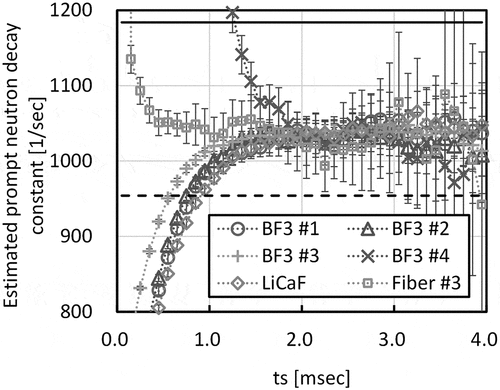
shows estimated values by applying the linear combination method to the neutron counts for each detector versus masking time
. Error bars (2
) in are evaluated by the bootstrap method with 10000 resampling. shows that the masking time dependence of
is dramatically reduced compared with those of the conventional α-fitting method. These results demonstrated that the linear combination is capable to reduce the HM effect by the inverse linear combination of neutron counts, and also, the linear combination method with 100 MeV proton beam has the capability to reduce the HM effect as well as with 14 MeV D-T neutron source shown in Ref [Citation17]. From the results in , the robustness of the linear combination method to neutron sources was importantly confirmed.
Figure 4. Estimated prompt neutron decay constant by the linear combination method.
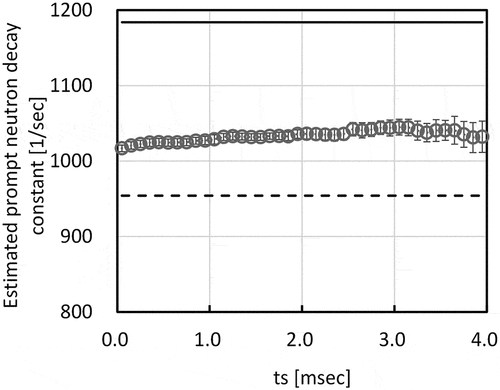
One can determine the best masking time by taking a masking time at which the residual defined by EquationEquation (3)(3)
(3) minimized since neutron counts can be approximately equal to a single exponential. shows the results of residual defined by EquationEquation (3)
(3)
(3) versus the masking time. Note that plots for ‘LCM’ are residuals obtained by the linear combination method using 6 detector (i.e.
) and the others are residual obtained by the conventional method for each detector (i.e.
). As shown in , the residuals obtained by the linear combination are less than those by all detectors. This result indicates that the linear combination method could provide the best estimate from the viewpoint of minimizing the fitting error. The masking time at which the residual by the linear combination method is minimized is 0.3 m and we deduced the best estimate
[1/s] (2
). Then, the numerical result of
= 1183 [1/s] agreed well with the experimental one within the 1
range of nuclear data-induced uncertainty.
Figure 5. Residual defined by EquationEq. (3)(3)
(3) versus the masking time for each detector.
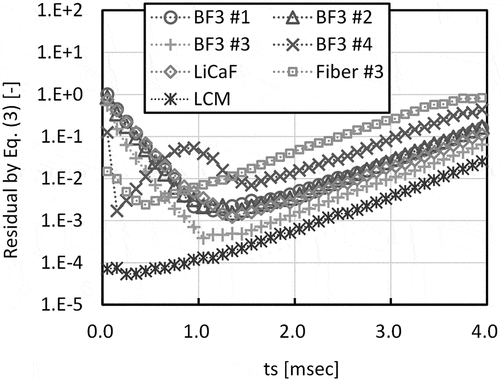
We could also deduce the best estimate of with the conventional method in a practical way: we evaluate
value for the minimum residual for each detector and we average the
values with weights minimizing the experimental standard deviation of the averaged
value. lists the
values for the minimum residual, their experimental standard deviation, and the masking time at which the residual minimized. Note that we determine the best masking time for BF-3 #4 detector as 1.6 ms at which the residual takes the second minimum since this detector was placed near the neutron source and
for BF-3 #4 detector for the masking time at which the residual is minimized (i.e. 0.2 ms) is apparently overestimated as shown in . From , we deduce the best estimate of
as
[1/s] (2
). This value and its experimental standard deviation are comparable to those of the linear combination method and the superiority of the linear combination method to the conventional method could not be confirmed from viewpoint of the experimental standard deviation. However, the linear combination method is derived theoretically and can minimize the fitting error. The linear combination method has also different properties from the conventional method: The linear combination method can extract a different mode exponential and there is an application of the linear combination method to the area ratio method which is a subcriticality measurement method and has the capability of absolute subciritcality measurements [Citation17,Citation33].
Table 4. values for the minimum residual.
5. Conclusion
We conducted the PNS experiments to confirm robustness of the linear combination, under the condition of using spallation neutrons generated by the interactions between 100 MeV protons and Pb-Bi target. Also, the prompt neutron decay constant was evaluated by the conventional α-fitting method and the linear combination method. From the experimental results, the linear combination method with spallation neutrons was interestingly found to be the capability to reduce the HM effect by an inverse linear combination of neutron counts as well as with 14 MeV D-T neutrons, and robustness of the linear combination method for spallation neutrons was importantly confirmed.
As a future work, on the basis of this research, the applicability of the linear combination method to the ADS could be confirmed by the time-dependent neutron transport calculations.
Disclosure statement
No potential conflict of interest was reported by the authors.
References
- Sugawara T, Katano R, Tsujimoto K. Impact of impurity in transmutation cycle on neutronics design of revised accelerator-driven system. Ann Nucl Energy. 2018;111:449–459.
- Sugawara T, Takei H, Oizumi A, et al. Research and development activities for accelerator-driven system in JAEA. Prog Nucl Energy. 2018;106:27–33.
- Mukaiyama T, Nakano M, Mizoo N. Reactivity measurement in a far-subcritical fast system (II) neutron source multiplication method. Ibaraki: Japan Atomic Energy Research Institute; 1975. JAERI-M 6067.
- Feynman RP, Hoffmann D, Serber R. Dispersion of the neutron emission in U-235 fission. J Nucl Eng. 1956;3:64–69.
- Sjöstrand NG. Measurements on a subcritical reactor using a pulsed neutron source. Ark Feys. 1956;11:233–246.
- Simmons BE, King S. A pulsed neutron technique for reactivity determination. Nucl Sci Eng. 1958;3:595–608.
- Research committee on reactor physics. Activity report of working party on reactor physics of accelerator-driven system. Ibaraki: Japan Atomic Energy Research Institute; 2001. JAERI-Review 2001-047 [Japanese].
- Soule R, Assal W, Chaussonnet P, et al. Neutronic studies in support of accelerator-driven systems: the MUSE experiments in the MASURCA facility. Nucl Sci Technol. 2004;148:124–152.
- Persson C, Fokau A, Serafimovich I, et al. Pulsed neutron source measurements in the subcritical ads experiment YALINA-booster. Ann Nucl Energy. 2008;35:2357–2364.
- Uyttenhove W, Baeten P, Van Den Eynde G, et al. The neutronic design of a critical lead reflected zero-power reference core for on-line subcriticality measurements in accelerator-driven systems. Ann Nucl Energy. 2011;38:1519–1526.
- Iwamoto H, Nishihara K, Yagi T, et al. On-line subcriticality measurement using a pulsed spallation neutron source. J Nucl Sci Technol. 2017;54:432–443.
- Pyeon CH, Vu TM, Yamanaka M, et al. Reaction rate analyses of accelerator-driven system experiments with 100 MeV protons at Kyoto University Critical Assembly. J Nucl Sci Technol. 2018;55:190–198.
- Yamamoto T, Sakamoto H. Effect of higher harmonics in the area-ratio pulsed neutron source technique. Ann Nucl Energy. 2018;108:286–294.
- Taninaka H, Hashimoto K, Pyeon CH, et al. Determination of lambda-mode eigenvalue separation of a thermal accelerator-driven system from pulsed neutron experiment. J Nucl Sci Technol. 2012;47:376–383.
- Pyeon CH, Yamanaka M, Endo T, et al. Experimental benchmarks on kinetic parameters in accelerator-driven system with 100 MeV protons at Kyoto University Critical Assembly. Ann Nucl Energy. 2017;105:346–354.
- Katano R. Estimation method of prompt neutron decay constant reducing higher order mode effect by linear combination. Nucl Sci Eng. 2018;193:431–439.
- Katano R, Pyeon CH, Yamanaka M. Application of linear combination method to pulsed neutron source measurement at Kyoto University Critical Assembly. Nucl Sci Eng. 2019;1–9. [in print]. DOI:10.1080/00295639.2019.1624084.
- Pyeon CH, Yamanaka M, Kim SH, et al. Benchmarks of subcriticality in accelerator-driven system at Kyoto University Critical Assembly. Nucl Eng Technol. 2017;49:1234–1239.
- Levenberg K. A method for the solution of certain non-linear problems in least squares. Quart Appl Math. 1944;2:164–168.
- Marquardt DW. An algorithm for least-squares estimation of nonlinear parameters. J Soc Indus Appl Math. 1963;11:431–441.
- Oliphant TE. Python for scientific computing. Comput Sci Engl. 2007;9:10–20.
- Kong C, Choe J, Yum S, et al. Application of advanced rossi-alpha technique to reactivity measurements at Kyoto University Critical Assembly. Ann Nucl Energy. 2018;118:92–98.
- Watanabe K, Kondo Y, Yamazaki A, et al. Study on fast luminescence component induced by gamma-rays in Ce doped LiCaAlF6 scintillators. Radiat Meas. 2014;71:158–161.
- Yagi T, Pyeon CH, Misawa T. Application of wavelength shifting fiber to subcriticality measurements. Appl Radiat Isot. 2013;72:11–15.
- Endo T, Yamamoto A. Comparison of theoretical formula and bootstrap method for statistical error estimation of Feynman-α method. Ann Nucl Energy. 2019;124:606–615.
- Werner CJ, Bull JS, Solomon CJ, et al. MCNP version 6.2 release notes. New Mexico: Los Alamos National Laboratory; 2018. LA-UR-18-20808.
- Shibata K, Iwamoto O, Nakagawa T, et al. JENDL-4.0: A new library for nuclear science and engineering. J Nucl Sci Technol. 2011;48:1–30.
- Endo T, Chiba G, Van Rooijen WFG, et al. Experimental analysis and uncertainty quantification using random sampling technique for ADS experiments at KUCA. J Nucl Sci Technol. 2018;55:450–459.
- Sugino K, Jin T, Hazama T, et al. Preparation of fast reactor group constant sets UFLIB.J40 and JFS-3-J4.0 based on the JENDL-4.0 data. Ibaraki: Japan Atomic Energy Agency; 2011. JAEA-Data/Code 2011-017.
- MacFarlane ER, Muir WD The NJOY nuclear data processing system version 91. Los Alamos, USA: Los Alamos National Laboratory; 1994. LA-12740-M.
- Yokoyama K, Hazama T, Numata K, et al. Development of comprehensive and versatile framework for reactor analysis, MARBLE. Ann Nucl Energy. 2014;66:51–60.
- Yamanaka M, Pyeon CH. Benchmarks of criticality in solid-moderated and solid-reflected cores at Kyoto University Critical Assembly. Nucl Sci Eng. 2019;193:404–416.
- Katano R. Area ratio method via linear combination of the neutron counts in pulsed neutron source experiment. Proceedings 9th International Conference on Nuclear Engineering (ICONE-27); 2019 May 19–24; Tsukuba, Japan. ICONE27-1327.

